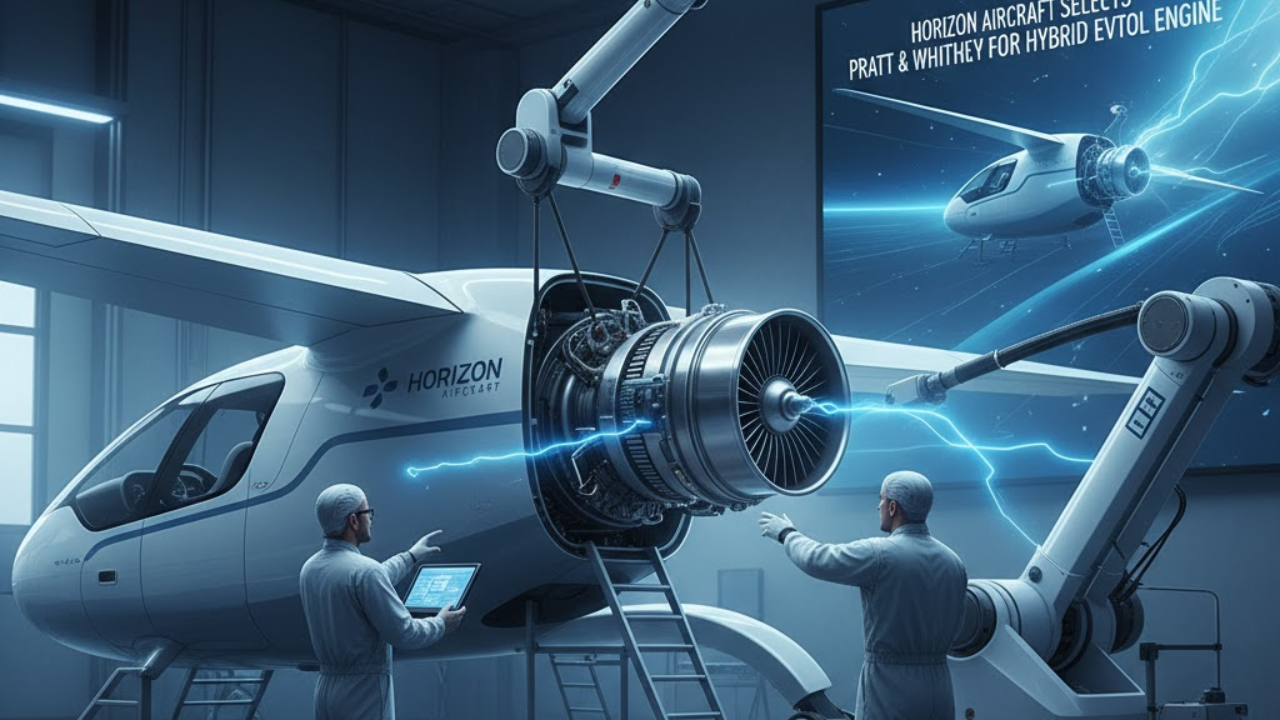
Spain & Italy Cruise to World Cup Qualifier Wins
Spain thrash Bulgaria 4-0 as Merino scores twice, while Italy secures playoff spot with 3-0 win over

Canada is taking a decisive step toward the future of sustainable flight. On 14 October 2025, Horizon Aircraft, a leading Canadian eVTOL manufacturer, announced its selection of Pratt & Whitney Canada’s PT6A engine to power its hybrid-electric vertical take-off and landing (eVTOL) aircraft.
This collaboration marks a significant milestone in advanced air mobility, combining Pratt & Whitney’s decades of aviation reliability with Horizon’s innovative hybrid-electric propulsion technology. The result could reshape regional aviation by offering a balance of efficiency, range, and safety—traits often missing from fully electric prototypes.
Horizon Aircraft’s decision to use the PT6A engine goes beyond technical specifications—it symbolizes a bridge between proven aerospace heritage and next-generation technology.
The PT6A engine is one of the world’s most trusted propulsion systems, with over 64,000 engines produced and 500 million flight hours logged. Its reliability, adaptability, and performance under harsh conditions make it the ideal power source for hybrid aircraft that demand both endurance and innovation.
For Horizon, integrating this engine means leveraging a certified, well-understood platform as the generator in its hybrid powertrain, producing electrical energy for lift fans and propulsion systems while maintaining a strong safety redundancy.
This is the future of flight: traditional turbines not replaced, but reimagined—serving as power generators in clean, hybrid systems designed for both urban and regional missions.
Horizon’s aircraft—known as the Cavorite X7—represents a unique vision for air mobility. Unlike all-electric aircraft that depend solely on batteries, the X7 blends electric propulsion with the dependable performance of a turbine generator.
During take-off, the aircraft uses multiple electric lift fans to ascend vertically. Once airborne, it transitions to forward flight, retracting its fans into the wings for aerodynamic efficiency. At that stage, the PT6A turbine engages as an onboard power generator, continuously supplying electricity to the motors and recharging batteries mid-flight.
This design gives the X7 exceptional versatility. It can take off and land in tight spaces like a helicopter but fly like a conventional aircraft—quiet, efficient, and fast. It also eliminates the range limitations that plague pure electric eVTOLs, achieving up to 800 kilometers of range and cruise speeds of over 450 km/h.
While full-electric flight remains the long-term goal for sustainable aviation, hybrid systems offer the most practical path to commercialization in the near future.
Battery technology, though advancing rapidly, still struggles with energy density, weight, and charging time. Hybrid systems solve these issues by combining electric propulsion’s quiet, efficient qualities with the range and reliability of combustion-based generation.
This approach ensures:
Extended range—three to five times farther than battery-only aircraft.
Faster turnaround, as refueling takes minutes compared to lengthy recharging.
Safer redundancy—if the battery system fails, the turbine sustains flight.
Easier certification with aviation authorities, since turbine systems are proven and familiar.
In essence, hybrid propulsion serves as a bridge technology—an achievable step between today’s fossil-fuel aircraft and tomorrow’s fully electric fleets.
Horizon Aircraft’s CEO, Brandon Robinson, highlighted the importance of selecting a partner that matches Horizon’s pragmatic engineering philosophy. “Our collaboration with Pratt & Whitney Canada represents a pivotal milestone in building the world’s most practical hybrid-electric aircraft. The PT6A engine gives us proven reliability and range that allow electric flight to become viable for real-world missions.”
Meanwhile, Denis Parisien, Vice President of Hybrid Propulsion at Pratt & Whitney Canada, expressed enthusiasm about extending the PT6A legacy into the electric age. “The hybrid era in aviation won’t emerge overnight—it will evolve from proven systems. Integrating the PT6A into Horizon’s aircraft is an example of how traditional aviation and innovation can come together to accelerate sustainable flight.”
The hybrid propulsion system of the Cavorite X7 operates in three distinct phases.
Take-Off and Hover: Electric lift fans powered by battery energy provide silent and emission-free vertical lift. The PT6A remains on standby, ensuring backup power if needed.
Transition and Cruise: Once airborne, the aircraft’s lift fans retract, wings generate aerodynamic lift, and the PT6A turbine starts producing electrical energy. This energy powers the main propellers while simultaneously recharging onboard batteries.
Descent and Landing: As the aircraft descends, power requirements drop. Electric propulsion takes over again, providing precision control and near-silent operation for landing.
This sequence ensures both operational flexibility and high energy efficiency while reducing emissions and noise—two key hurdles for urban and regional air mobility adoption.
Canada is uniquely positioned to benefit from the hybrid aviation revolution. With its deep aerospace heritage, strong regulatory framework, and access to clean energy, the country is becoming a testing ground for green flight technologies.
Horizon’s partnership with Pratt & Whitney strengthens this ecosystem by aligning startups and established OEMs under one vision—sustainable, scalable aviation.
The project supports multiple national objectives:
Clean technology leadership, contributing to Canada’s Net Zero by 2050 goals.
Economic diversification, through advanced manufacturing and exports.
Job creation, in engineering, R&D, and maintenance sectors.
Cross-provincial collaboration, linking Ontario’s innovation startups with Quebec’s manufacturing expertise.
This alliance isn’t just about a single aircraft—it’s about redefining Canada’s role in global aerospace.
Around the world, hundreds of companies are racing to develop electric and hybrid aircraft. U.S.-based startups like Joby Aviation, Beta Technologies, and Archer Aviation are leading in fully electric urban air taxis, while European firms such as Dufour Aerospace (Switzerland) and VoltAero (France) explore hybrid propulsion models.
Horizon’s edge lies in its balanced engineering philosophy—it prioritizes certification feasibility, range, and commercial utility rather than futuristic concepts. Where others aim for short, urban hops, Horizon targets regional routes connecting smaller cities, islands, or remote communities.
This gives it a real-world application that can scale faster, especially in vast geographies like Canada where intercity transport remains underserved.
The hybrid design is a win for both the planet and operators. By combining electric propulsion with efficient turbines, the system cuts carbon emissions by up to 70% compared to similar conventional aircraft.
When powered by Sustainable Aviation Fuel (SAF), total lifecycle emissions could drop by more than 80%. Noise pollution is also drastically reduced, making hybrid aircraft ideal for suburban airports and urban peripheries.
From an economic perspective, hybrid systems lower fuel and maintenance costs while improving operational uptime. Operators can serve longer routes, carry higher payloads, and refuel quickly—key advantages for air taxi, medical evacuation, cargo, and regional travel missions.
Horizon’s development roadmap outlines a clear trajectory toward commercialization. Over the next two years, the company will focus on integrating the PT6A engine into its hybrid system and conducting rigorous ground and flight testing.
By 2027, Horizon expects to have a full-scale prototype undergoing certification testing with Transport Canada and the U.S. Federal Aviation Administration (FAA). Commercial deployment could follow by 2030, positioning Horizon among the first hybrid eVTOL manufacturers to enter service globally.
If successful, the Cavorite X7 could set a new benchmark for hybrid aircraft performance—proving that long-range, sustainable, and safe electric flight is not a distant dream but an achievable reality.
This collaboration between Horizon Aircraft and Pratt & Whitney Canada sends a strong signal across the global aviation sector: hybrid systems are the practical gateway to a cleaner future in flight.
It demonstrates that innovation doesn’t always mean abandoning legacy—it can mean enhancing it. The PT6A, one of aviation’s most time-tested engines, is now becoming the power generator of the electric age.
At the same time, Horizon’s pragmatic approach—rooted in achievable engineering and regulatory realism—provides a model for how aviation startups can succeed in a complex, safety-critical industry.
Together, these companies are not only shaping Canada’s aerospace evolution but also influencing how the world envisions sustainable air mobility.
Disclaimer
This article is for informational and educational purposes only. It does not constitute financial, technical, or legal advice. Readers should verify official statements from Horizon Aircraft and Pratt & Whitney Canada for the latest program details and certification updates.